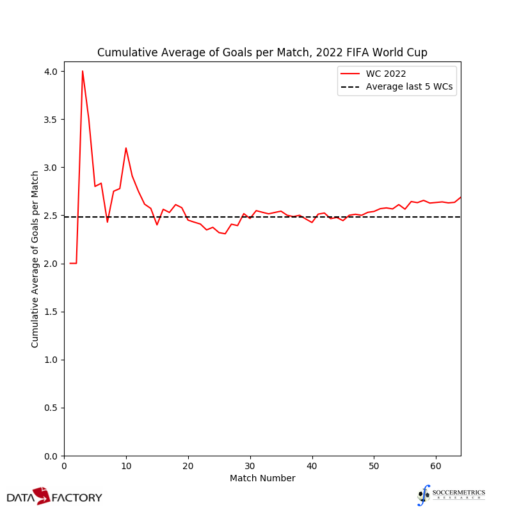Lionel Messi and his muchachos achieve glory in Qatar
Categories: Competition Analysis
Argentina won their third World Cup after a month that started with a mammoth shock and ended in not just the greatest and most thrilling World Cup final of all time, but arguably one of the greatest football matches of all time. Lionel Messi didn’t need to win the World Cup to achieve legendary status, but this tournament serves nonetheless as a personal vindication for him. If you look at the basic and advanced metrics, one could argue that no individual, since Diego Maradona in 1996 or Ronaldo in 2002, has dominated the World Cup finals to the extent that Messi did in Qatar.
Let’s first take a step back and look at this edition of the tournament as a whole. This World Cup saw the most goals in the history of the competition (171 goals, including 2 own-goals) and shots converted into goals at a much higher rate of 11.8%, compared to a conversion rate between 9-10% in club competitions. The goalscoring progressed according to the figure displayed below.

The early part of the group stage saw matches with a lot of goals (England vs Iran, France vs Australia, Spain vs Costa Rica) which caused the cumulative goal average to spike, but as the group stage progressed the frequency of low-scoring matches increased, resulting in the cumulative goal average regressing toward the historical average over the last 5 World Cup finals. Throughout the group stage, there were a total of six matches that ended goalless and nine matches decided by the minimum difference, so almost a third of the group stage matches saw one goal or fewer. Over the entire knockout stage, only two matches saw fewer than two goals: the Round of 16 match between Morocco and Spain, and the quarterfinal between Morocco and Portugal. The average number of goals in the knockout stage increased by 30% over that of the knockout stage, which is reflected in the cumulative average curve ticking upward.
At the team level, Argentina and France featured as the best teams in Qatar, which is what you would expect from the finalists. For a team that had a significant number of first-choice players unavailable due to injury, and suffered significant injuries to players at the start, France imposed themselves on their opponents from the first match to the last. (Yes, they did lose to Tunisia, but their place in the knockout phase was decided by then.) Argentina lost their opening match in an incomprehensible way, and were playing their way out of the World Cup during the first half against Mexico, but turned the match — and their World Cup journey — around with a decisive second half. France and Argentina were among the competition leaders in shots per 90 minutes, goals per 90 minutes, and expected goals per 90 minutes. Argentina stood out with their defensive performance: the fewest shots allowed per 90 minutes, and part of the group of sides that allowed less than 1.0 xGA per 90 (England, Brazil, Spain, Germany, and Ecuador were the others). Argentina’s vulnerability was that in moments where opposing teams were able to shots off, they were able to convert them at a much higher rate than the competition average. This vulnerability made matches tighter than they should have been in the quarterfinal against the Netherlands and the final against France. France’s vulnerability was their propensity to concede penalties — four in all that resulted in three goals conceded. (We won’t talk about what happened to the fourth.)
At the individual level, the competition was dominated by Lionel Messi and Kylian Mbappé, but Messi’s performance as a chance creator in the final third gave him the edge for best player of the tournament. Messi and Mbappé led the competition in goals, total shots, shots from open play, total expected goals, total non-penalty expected goals, and total touches in the final third. Mbappé dominated entries into the attacking left flank and the penalty area; Messi was dominant in the central area of the final third and the attack right flank. Messi led the competition in total expected assists and expected assists from open play. Furthermore, Messi’s teammates featured near the highest tiers of xG and xA contributions — Rodrigo de Paul, Enzo Fernández, and Alexis Mac Allister in terms of xA, and Lautaro Martínez and Julián Álvarez in terms of xG. (Yes, I know that Lautaro Martínez didn’t score a goal, which is after all the whole point.) Mbappé did have a number of teammates make significant contributions, such as Antoine Griezmann and Aurélien Tchouaméni for chance creation and Olivier Giroud for shot creation. In the end, Argentina finished the tournament with a superior midfield and young players who turned out to be difference-makers and match-winners, which in encouraging for Copa América later this year and the next World Cup finals in 2026.
As for best goalkeeper, I digress from FIFA’s Technical Study Group and select Yassine Bounou of Morocco, who allowed four goals (all of them in the semifinal and third-place game), had four clean sheets, and allowed -0.4 goals above expected. Morocco’s xGA metrics would have placed them in the middle of the World Cup finalists, but Bounou answered the call in normal time, extra time, and in the penalty shootouts when required.
There’s a lot more statistical information to digest from this World Cup, but as an overview of the competition, it’s best to stop here.
Match data used in the preparation of this post was provided by DataFactory Latinoaméricano.

